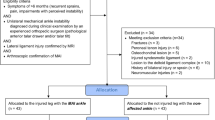Abstract
Purpose
We evaluated and compared kinematics of bilateral ankle, knee, and hip joints in patients with chronic unilateral ankle instability (CAI) with healthy controls.
Methods
Fifteen individuals diagnosed with CAI and a control group of 16 individuals were matched. Different peaks within the gait cycle (at different intervals) for the dorsiplantar, inversion/eversion, and abduction/adduction axis were compared between injured and uninjured sides of patients with CAI with a control group.
Results
Comparison of the uninjured ankle in CAI with the control group showed higher dorsiflexion in one peak of the stance phase (p = 0.003), higher inversion in one peak of the stance phase (p = 0.022), and the swing phase (p = 0.004). The hip joint of the uninjured side showed higher extension in one peak of the stance phase (p < 0.001), and two peaks of the swing phase (p < 0.05). Furthermore, it showed higher adduction in one peak of the foot flat to mid-stance phase (p = 0.001), higher abduction in one peak of the late swing phase (p = 0.047), and the swing phase (p = 0.032). The knee joint of the uninjured side showed higher flexion in all measured peaks of the gait cycle (p < 0.05) (except for one peak in the late swing phase) compared to the control group.
Conclusion
Chronic ankle instability results in altered biomechanics of the ipsilateral knee as well as the contralateral ankle, knee, and hip joints. The alterations caused by CAI may predispose patients to overuse and/or acute injuries of other joints of lower extremities during routine and sporting activity.




Similar content being viewed by others
Availability of data and material
Data will be accessible for authors and institutional by directly contacting the corresponding author upon reasonable request.
Code availability
N/A.
References
Herzog MM, Kerr ZY, Marshall SW, Wikstrom EA (2019) Epidemiology of ankle sprains and chronic ankle instability. J Athl Train 54(6):603–610
Roos KG, Kerr ZY, Mauntel TC, Djoko A, Dompier TP, Wikstrom EA (2017) The epidemiology of lateral ligament complex ankle sprains in National Collegiate Athletic Association sports. Am J Sports Med 45(1):201–209
McKay GD, Goldie P, Payne WR, Oakes B (2001) Ankle injuries in basketball: injury rate and risk factors. Br J Sports Med 35(2):103–108
Gribble PA, Bleakley CM, Caulfield BM, Docherty CL, Fourchet F, Fong DT-P, Hertel J, Hiller CE, Kaminski TW, McKeon PO (2016) Evidence review for the 2016 International Ankle Consortium consensus statement on the prevalence, impact and long-term consequences of lateral ankle sprains. Br J Sports Med 50(24):1496–1505
Attenborough AS, Hiller CE, Smith RM, Stuelcken M, Greene A, Sinclair PJ (2014) Chronic ankle instability in sporting populations. Sports Med 44(11):1545–1556
Hintermann B, Boss A, Schäfer D (2002) Arthroscopic findings in patients with chronic ankle instability. Am J Sports Med 30(3):402–409
Witchalls J, Blanch P, Waddington G, Adams R (2012) Intrinsic functional deficits associated with increased risk of ankle injuries: a systematic review with meta-analysis. Br J Sports Med 46(7):515–523. https://doi.org/10.1136/bjsports-2011-090137
Hubbard TJ, Kramer LC, Denegar CR, Hertel J (2007) Contributing factors to chronic ankle instability. Foot Ankle Int 28(3):343–354. https://doi.org/10.3113/fai.2007.0343
de Noronha M, Refshauge KM, Herbert RD, Kilbreath SL, Hertel J (2006) Do voluntary strength, proprioception, range of motion, or postural sway predict occurrence of lateral ankle sprain? Br J Sports Med 40 (10):824–828; discussion 828. https://doi.org/10.1136/bjsm.2006.029645
Koldenhoven RM, Hart J, Saliba S, Abel MF, Hertel J (2019) Gait kinematics & kinetics at three walking speeds in individuals with chronic ankle instability and ankle sprain copers. Gait Posture 74:169–175
Gribble PA, Delahunt E, Bleakley CM, Caulfield B, Docherty CL, Fong DT-P, Fourchet F, Hertel J, Hiller CE, Kaminski TW, McKeon PO, Refshauge KM, van der Wees P, Vicenzino W, Wikstrom EA (2014) Selection criteria for patients with chronic ankle instability in controlled research: a position statement of the International Ankle Consortium. J Athl Train 49(1):121–127. https://doi.org/10.4085/1062-6050-49.1.14
Meine MH, Zanotelli ML, Neumann J, Kiss G, de Jesus GT, Leipnitz I, Schlindwein ES, Fleck A Jr, Gleisner AL, de Mello BA, Marroni CA, Cantisani GP (2006) Randomized clinical assay for hepatic grafts preservation with University of Wisconsin or histidine-tryptophan-ketoglutarate solutions in liver transplantation. Transplant Proc 38(6):1872–1875. https://doi.org/10.1016/j.transproceed.2006.06.071
Chinn L, Dicharry J, Hertel J (2013) Ankle kinematics of individuals with chronic ankle instability while walking and jogging on a treadmill in shoes. Phys Ther Sport 14(4):232–239
Gribble PA, Robinson RH (2009) Alterations in knee kinematics and dynamic stability associated with chronic ankle instability. J Athl Train 44(4):350–355
Kim H, Son SJ, Seeley MK, Hopkins JT (2019) Altered movement biomechanics in chronic ankle instability, coper, and control groups: energy absorption and distribution implications. J Athl Train 54(6):708–717
Moisan G, Mainville C, Descarreaux M, Cantin V (2021) Lower limb biomechanics in individuals with chronic ankle instability during gait: a case-control study. J Foot Ankle Res 14(1):36. https://doi.org/10.1186/s13047-021-00476-6
Acknowledgements
The authors would like to thank all the patients and their families for kindly taking part in this study.
Author information
Authors and Affiliations
Corresponding author
Ethics declarations
Ethics approval
This study was approved by the Iran University of Science and Technology.
Consent to participate
All participants gave the written and informed consent to enter the study.
Consent for publication
All participants gave their consent for their data to be published.
Conflict of interest
The authors declare no competing interests.
Additional information
Publisher's note
Springer Nature remains neutral with regard to jurisdictional claims in published maps and institutional affiliations.
Rights and permissions
About this article
Cite this article
Ziabari, E.Z., Razi, M., Haghpanahi, M. et al. Does ipsilateral chronic ankle instability alter kinematics of the other joints of the lower extremities: a biomechanical study. International Orthopaedics (SICOT) 46, 241–248 (2022). https://doi.org/10.1007/s00264-021-05139-6
Received:
Accepted:
Published:
Issue Date:
DOI: https://doi.org/10.1007/s00264-021-05139-6




